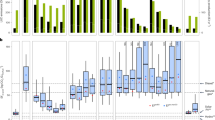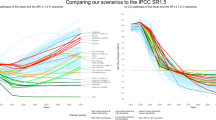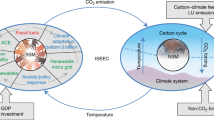Abstract
The Intergovernmental Panel on Climate Change's Special Report on Renewable Energy Sources and Climate Change Mitigation (SRREN) assesses the role of bioenergy as a solution to meeting energy demand in a climate-constrained world. Based on integrated assessment models, the SRREN states that deployed bioenergy will contribute the greatest proportion of primary energy among renewable energies and result in greenhouse-gas emission reductions. The report also acknowledges insights from life-cycle assessments, which characterize biofuels as a potential source of significant greenhouse-gas emissions and environmental harm. The SRREN made considerable progress in bringing together contrasting views on indirect land-use change from inductive bottom-up studies, such as life-cycle analysis, and deductive top-down assessments. However, a reconciliation of these contrasting views is still missing. Tackling this challenge is a fundamental prerequisite for future bioenergy assessment.
This is a preview of subscription content, access via your institution
Access options
Subscribe to this journal
Receive 12 print issues and online access
$209.00 per year
only $17.42 per issue
Buy this article
- Purchase on Springer Link
- Instant access to full article PDF
Prices may be subject to local taxes which are calculated during checkout




Similar content being viewed by others
References
Van Vuuren, D., van Vliet, J. & Stehfest, E. Future bio-energy potential under various natural constraints. Energ. Policy 37, 4220–4230 (2009).
Leimbach, M. et al. Technological change and international trade — Insights from REMIND.-R. Energ. J. 31, 109–136 (2010).
Fargione, J. et al. Land clearing and the biofuel carbon debt. Science 319, 1235–1238 (2008).
Gibbs, H. K. et al. Carbon payback times for crop-based biofuel expansion in the tropics: The effects of changing yield and technology. Environ. Res. Lett. 3, 034001 (2008).
Searchinger, T. et al. Use of US croplands for biofuels increases greenhouse gases through emissions from land-use change. Science 319, 1238–1240 (2008).
Plevin, R. J. et al. Greenhouse gas emissions from biofuels' indirect land use change are uncertain but may be much greater than previously estimated. Environ. Sci. Technol. 44, 8015–8021 (2010).
Fargione, J., Plevin, R. J. & Hill, J. The ecological impact of biofuels. Annu. Rev. Ecol. Evol. Syst. 41, 351–377 (2010).
IPCC Special Report on Renewable Energy Sources and Climate Change Mitigation (eds Edenhofer, O., Pichs-Madruga, R., Sokona, Y. & Seyboth, K.) (Cambridge Univ. Press, 2011).
Chum, H. et al. in IPCC Special Report on Renewable Energy Sources and Climate Change Mitigation (eds Edenhofer, O., Pichs-Madruga, R., Sokona, Y. & Seyboth, K.) 209–332 (Cambridge Univ. Press, 2011).
Sathaye, J. et al. in IPCC Special Report on Renewable Energy Sources and Climate Change Mitigation (eds Edenhofer, O., Pichs-Madruga, R., Sokona, Y. & Seyboth, K.) 707–790 (Cambridge Univ. Press, 2011).
Fischedick, M. et al. in IPCC Special Report on Renewable Energy Sources and Climate Change Mitigation (eds Edenhofer, O., Pichs-Madruga, R., Sokona, Y. & Seyboth, K.) 791–864 (Cambridge Univ. Press, 2011).
Hertel, T. W. et al. Effects of US maize ethanol on global land use and greenhouse gas emissions: Estimating market-mediated responses. BioScience 60, 223–231 (2010).
Lapola, D. M. et al. Indirect land-use changes can overcome carbon savings from biofuels in Brazil. Proc. Natl Acad. Sci. USA 107, 3388–3393 (2010).
Al-Riffai, P., Dimaranan, B. & Laborde, D. Global Trade and Environmental Impact Study of the EU Biofuels Mandate (International Food Policy Research Institute, 2010).
Anderson-Teixeira, K. J. & Delucia, E. H. The greenhouse gas value of ecosystems. Glob. Change Biol. 17, 425–438 (2010).
Kim, S. & Dale, B. E. Indirect land use change for biofuels: Testing predictions and improving analytical methodologies. Biomass Bioenerg. 35, 3235–3240 (2011).
Thompson, W., Whistance, J. & Meyer, S. Effects of US biofuel policies on US and world petroleum product markets with consequences for greenhouse gas emissions. Energ. Policy 39, 5509–5518 (2011).
Rajagopal, D., Hochman, G. & Zilberman, D. Indirect fuel use change (IFUC) and the lifecycle environmental impact of biofuel policies. Energ. Policy 39, 228–233 (2011).
McKone, T. E. et al. Grand challenges for life-cycle assessment of biofuels. Environ. Sci. Technol. 45, 1751–1756 (2011).
Hoefnagels, R., Smeets, E. & Faaij, A. Greenhouse gas footprints of different biofuel production systems. Renew. Sust. Energ. Rev. 14, 1661–1694 (2010).
Edwards, R., Szekeres, S., Neuwahl, F. & Mahieu, V. Biofuels in the European Context: Facts and Uncertainties (European Commission, Joint Research Centre, 2008).
International Energy Agency Sustainable Production of Second-Generation Biofuels: Potential and Perspectives in Major Economies and Developing Countries (IEA, 2010).
Brander, M. et al. Methodology and Evidence Base on the Indirect Greenhouse Gas Effects of Using Wastes, Residues, and By-products for Biofuels and Bioenergy (Renewable Fuels Agency and Department for Energy and Climate Change, 2009).
Richard, T. L. Challenges in scaling up biofuels infrastructure. Science 329, 793–796 (2010).
Tilman, D. et al. Beneficial biofuels — The food, energy, and environment trilemma. Science 325, 270–271 (2009).
Service, R. F. Is there a road ahead for cellulosic ethanol? Science 329, 784–785 (2010).
Azar, C., Lindgren, K., Larson, E. & Möllersten, K. Carbon capture and storage from fossil fuels and biomass — Costs and potential role in stabilizing the atmosphere. Climatic Change 74, 47–79 (2006).
Riahi, K., Grübler, A. & Nakicenovic, N. Scenarios of long-term socio-economic and environmental development under climate stabilization. Technol. Forecast. Soc. 74, 887–935 (2007).
Edenhofer, O. et al. The economics of low stabilization: Model comparison of mitigation strategies and costs. Energ. J. 31 (Special Issue 1), 11–48 (2010).
Dornburg, V. et al. Bioenergy revisited: Key factors in global potentials of bioenergy. Energ. Environ. Sci. 3, 258–267 (2010).
German Advisory Council on Global Change World in Transition Future Bioenergy and Sustainable Land Use (WBGU, 2009).
Beringer, T., Lucht, W. & Schaphoff, S. Bioenergy production potential of global biomass plantations under environmental and agricultural constraints. GCB Bioenerg. 3, 299–312 (2011).
Haberl, H. et al. The global technical potential of bio-energy in 2050 considering sustainability constraints. Curr. Opin. Environ. Sust. 2, 394–403 (2010).
Erb, K-H. et al. Eating the Planet: Feeding and Fuelling the World Sustainably, Fairly and Humanely — A Scoping Study (Institute of Social Ecology and PIK Potsdam, 2009).
Van Vuuren, D. et al. Exploring IMAGE model scenarios that keep greenhouse gas radiative forcing below 3 W/m2 in 2100. Energ. Econ. 32, 1105–1120 (2010).
Lotze-Campen, H. et al. Scenarios of global bioenergy production: The trade-offs between agricultural expansion, intensification and trade. Ecol. Model. 221, 2188–2196 (2009).
Smeets, E. M. W., Faaij, A. P. C., Lemandowski, I. & Turkenburg, W. A bottom-up assessment and review of global bio-energy potentials to 2050. Prog. Energ. Combust. 33, 56–106 (2007).
Hoogwijk, M. et al. Potential of biomass energy out to 2100, for four IPCC SRES land-use scenarios. Biomass Bioenerg. 29, 225–257 (2005).
Sims, R. E. H. et al. Energy crops: Current status and future prospects. Glob. Change Biol. 12, 2054–2076 (2006).
Field, C. B., Campbell, J. E. & Lobell, D. B. Biomass energy: The scale of the potential resource. Trends Ecol. Evol. 23, 65–72 (2008).
Campbell, J. E., Lobell, D. B., Genova, R. C. & Field, C. B. The global potential of bioenergy on abandoned agriculture lands. Environ. Sci. Technol. 42, 5791–5794 (2008).
Food & Agriculture Organization of the United Nations Statistical Database http://faostat.fao.org (FAOSTAT 2009).
Fischer, R. A. & Edmeades, G. O. Breeding and cereal yield progress. Crop Sci. 50, 85–98 (2010).
Licker, R. et al. Mind the gap: How do climate and agricultural management explain the 'yield gap' of croplands around the world? Glob. Ecol. Biogeogr. 19, 769–782 (2010).
Wise, M. et al. Implications of limiting CO2 concentrations for land use and energy. Science 324, 1183–1186 (2009).
Bruinsma, J. World Agriculture: Towards 2015/2030. An FAO Perspective (Food and Agriculture Organization, 2003).
Popp, A. et al. The potential contribution of bioenergy to climate change mitigation including its costs and side effects. Environ. Res. Lett. 6, 034017 (2011).
Melillo, J. M. et al. Indirect emissions from biofuels: How important? Science 326, 1397–1399 (2009).
Sokolov, A. P. et al. Probabilistic forecast for twenty-first-century climate based on uncertainties in emissions (without policy) and climate parameters. J. Clim. 22, 5175–5204 (2009).
Krey, V. & Clarke, L. Role of renewable energy in climate mitigation: A synthesis of recent scenarios. Clim. Policy 11, 1131–1158 (2011).
Reilly, J. & Paltsev, S. in Economic Analysis of Land Use in Global Climate Change Policy (eds Rose, S., Hertel, T., & Tol, R.) 184–207 (Routledge, 2009).
Gurgel, A., Reilly, J. & Paltsev, S. Potential land use implications of a global biofuels industry. J. Agr. Food Ind. Organ. 5, http://dx.doi.org/10.2202/1542-0485.1202 (2007).
Vuuren, D. van. et al. Stabilizing greenhouse gas concentrations at low levels: An assessment of reduction strategies and costs. Climatic Change 81, 119–159 (2007).
Calvin, K. et al. Limiting climate change to 450 ppm CO2 equivalent in the 21st century. Energ. Econ. 31, S107–S120 (2009).
Luderer, G. et al. The economics of decarbonizing the energy system — Results and insights from the RECIPE model intercomparison. Climatic Change http://dx.doi.org/10.1007/s10584-011-0105-x (2011).
Popp, A. et al. On sustainability of bioenergy production: Integrating co-emissions from agricultural intensification. Biomass Bioenerg. 35, 4770–4780 (2010).
Meinshauen, M. et al. Greenhouse-gas emission targets for limiting global warming to 2 °C. Nature 458, 1158–1163 (2009).
Ackerman, F., DeCanio, S. J., Howarth, R. B. & Sheeran, K. Limitations of integrated assessment models of climate change. Climatic Change 95, 297–315 (2009).
Cullenward, D., Schipper, L., Sudarshan, A. & Howarth, R. Psychohistory revisited: fundamental issues in forecasting climate futures. Climatic Change 104, 457–472 (2011).
Socolow, R. High-consequence outcomes and internal disagreements: Tell us more, please. Climatic Change 108, 775–790 (2011).
Putnam, H. The Collapse of the Fact/Value Dichotomy. And other Essays (Harvard Univ. Press, 2004).
Habermas, J. Technik und Wissenschaft als Ideologie (Suhrkamp, 1968).
Edenhofer, O. & Seyboth, K. in Encyclopedia of Energy, Natural Resource and Environmental Economics (ed. Shogren, J. F.) (Elsevier, in the press).
Mastrandrea, M. et al. The IPCC AR5 guidance note on consistent treatment of uncertainties: a common approach across the working groups. Climatic Change 108, 675–691 (2011).
Pidgeon, N. & Fischhoff, B. The role of social and decision sciences in communicating uncertain climate risks. Nature Clim. Change 1, 35–41 (2011).
Lange, M. The GHG balance of biofuels taking into account land use change. Energ. Policy 5, 2373–2385 (2011).
Creutzig, F., McGlynn, E., Minx, J. & Edenhofer, O. Climate policies for road transport revisited (I): Evaluation of the current framework. Energ. Policy 39, 2396–2406 (2011).
Soimakallio, S. & Koponen, K. How to ensure greenhouse gas emission reductions by increasing the use of biofuels? — Suitability of the European Union sustainability criteria. Biomass Bioenerg. 35, 3504–3513 (2011).
Havlík, P. et al. Global land-use implications of first and second generation biofuel targets. Energ. Policy 39, 5690–5702 (2011).
Sims, R. E. H., Mabee, W., Saddler, J. N. & Taylor, M. An overview of second generation biofuel technologies. Bioresource Technol. 101, 1570–1580 (2010).
Plevin, R. J. Life Cycle Regulation of Transportation Fuels: Uncertainty and its Policy Implications PhD thesis, Univ. California, Berkeley (2010).
DeCicco, J. M. Addressing Biofuel GHG Emissions in the Context of a Fossil-Based Carbon Cap (University of Michigan, School of Natural Resources and Environment, 2009).
Morton, D. C. et al. Cropland expansion changes deforestation dynamics in the southern Brazilian Amazon. Proc. Natl Acad. Sci. USA 103, 14637–14641 (2006).
Van Dam, J., Junginger, M. & Faaij, A. P. C. From the global efforts on certification of bioenergy towards an integrated approach based on sustainable land use planning. Renew. Sust. Energ. Rev. 14, 2445–2472 (2010).
McMichael, A. J., Powles, J. W., Butler, C. D. & Uauy, R. Food, livestock production, energy, climate change, and health. Lancet 370, 1253–1263 (2007).
Creutzig, F. & He, D. Climate change mitigation and co-benefits of feasible transport demand policies in Beijing. Transport. Res. D 14, 120–131 (2009).
Stehfest, E. et al. Climate benefits of changing diet. Climatic Change 95, 83–102 (2009).
Popp, A., Lotze-Campen, H. & Bodirsky, B. Food consumption, diet shifts and associated non-CO2 greenhouse gases from agricultural production. Glob. Environ. Change 20, 451–462 (2010).
Cassman, K. G. Ecological intensification of cereal production systems: Yield potential, soil quality, and precision agriculture. Proc. Natl Acad. Sci. USA 96, 5952–5959 (1999).
Schlenker, W. & Lobell, D. B. Robust negative impacts of climate change on African agriculture. Environ. Res. Lett. 5, 014010 (2010).
Lobell, D. B., Bänziger, M., Magorokosho, C. & Vivek, B. Nonlinear heat effects on African maize as evidenced by historical yield trials. Nature Clim. Change 1, 42–45 (2011).
Tebaldi, C. & Lobell, D. B. Towards probabilistic projections of climate change impacts on global crop yields. Geophys. Res. Lett. 35, 1–6 (2008).
Acknowledgements
We thank R. Socolow, R. Williams, C. von Stechow and U. Fritsche for helpful discussions. We gratefully acknowledge financial support by the Michael Otto Stiftung and the German Federal Ministry of Education and Research funded project GLUES (Global Assessment of Land Use Dynamics, Greenhouse Gas Emissions and Ecosystem Services).
Author information
Authors and Affiliations
Corresponding author
Ethics declarations
Competing interests
The authors declare no competing financial interests.
Supplementary information
Supplementary Information
Reconciling top-down and bottom-up modelling on future bioenergy deployment (PDF 364 kb)
Rights and permissions
About this article
Cite this article
Creutzig, F., Popp, A., Plevin, R. et al. Reconciling top-down and bottom-up modelling on future bioenergy deployment. Nature Clim Change 2, 320–327 (2012). https://doi.org/10.1038/nclimate1416
Published:
Issue Date:
DOI: https://doi.org/10.1038/nclimate1416
This article is cited by
-
Impact of declining renewable energy costs on electrification in low-emission scenarios
Nature Energy (2021)
-
Pricing indirect emissions accelerates low—carbon transition of US light vehicle sector
Nature Communications (2021)
-
A global yield dataset for major lignocellulosic bioenergy crops based on field measurements
Scientific Data (2018)
-
A meta-analysis of the greenhouse gas abatement of bioenergy factoring in land use changes
Scientific Reports (2018)
-
Industrial ecology in integrated assessment models
Nature Climate Change (2017)



